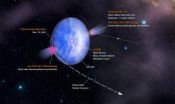(Press-News.org) In December 2010, a pair of mismatched stars in the southern constellation Crux whisked past each other at a distance closer than Venus orbits the sun. The system possesses a so-far unique blend of a hot and massive star with a compact fast-spinning pulsar. The pair's closest encounters occur every 3.4 years and each is marked by a sharp increase in gamma rays, the most extreme form of light.
The unique combination of stars, the long wait between close approaches, and periods of intense gamma-ray emission make this system irresistible to astrophysicists. Now, a team using NASA's Fermi Gamma-ray Space Telescope to observe the 2010 encounter reports that the system displayed fascinating and unanticipated activity.
"Even though we were waiting for this event, it still surprised us," said Aous Abdo, a Research Assistant Professor at George Mason University in Fairfax, Va., and a leader of the research team.
Few pairings in astronomy are as peculiar as high-mass binaries, where a hot blue-white star many times the sun's mass and temperature is joined by a compact companion no bigger than Earth -- and likely much smaller. Depending on the system, this companion may be a burned-out star known as a white dwarf, a city-sized remnant called a neutron star (also known as a pulsar) or, most exotically, a black hole.
Just four of these "odd couple" binaries were known to produce gamma rays, but in only one of them did astronomers know the nature of the compact object. That binary consists of a pulsar designated PSR B1259-63 and a 10th-magnitude Be-type star known as LS 2883. The pair lies 8,000 light-years away.
The pulsar is a fast-spinning neutron star with a strong magnetic field. This combination powers a lighthouse-like beam of energy, which astronomers can easily locate if the beam happens to sweep toward Earth. The beam from PSR B1259-63 was discovered in 1989 by the Parkes radio telescope in Australia. The neutron star is about the size of Washington, D.C., weighs about twice the sun's mass, and spins almost 21 times a second.
The pulsar follows an eccentric and steeply inclined orbit around LS 2883, which weighs roughly 24 solar masses and spans about nine times its size. This hot blue star sits embedded in a disk of gas that flows out from its equatorial region.
At closest approach, the pulsar passes less than 63 million miles from its star -- so close that it skirts the gas disk around the star's middle. The pulsar punches through the disk on the inbound leg of its orbit. Then it swings around the star at closest approach and plunges through the disk again on the way out.
"During these disk passages, energetic particles emitted by the pulsar can interact with the disk, and this can lead to processes that accelerate particles and produce radiation at different energies," said study co-author Simon Johnston of the Australia Telescope National Facility in Epping, New South Wales. "The frustrating thing for astronomers is that the pulsar follows such an eccentric orbit that these events only happen every 3.4 years."
In anticipation of the Dec. 15, 2010, closest approach, astronomers around the world mounted a multiwavelength campaign to observe the system over a broad energy range, from radio wavelengths to the most energetic gamma rays detectable. The observatories included Fermi and NASA's Swift spacecraft; the European space telescopes XMM-Newton and INTEGRAL; the Japan-U.S. Suzaku satellite; the Australia Telescope Compact Array; optical and infrared telescopes in Chile and South Africa; and the High Energy Stereoscopic System (H.E.S.S.), a ground-based observatory in Namibia that can detect gamma rays with energies of trillions of electron volts, beyond Fermi's range. (For comparison, the energy of visible light is between two and three electron volts.)
"When you know you have a chance of observing this system only once every few years, you try to arrange for as much coverage as you can," said Abdo, the principal investigator of the NASA-funded international campaign. "Understanding this system, where we know the nature of the compact object, may help us understand the nature of the compact objects in other, similar systems."
Despite monitoring of the system with the EGRET telescope aboard NASA's Compton Gamma-Ray Observatory in the 1990s, gamma-ray emission in the billion-electron-volt (GeV) energy range had never been seen from the binary.
Late last year, as the pulsar headed toward its massive companion, the Large Area Telescope (LAT) aboard Fermi discovered faint gamma-ray emission.
"During the first disk passage, which lasted from mid-November to mid-December, the LAT recorded faint yet detectable emission from the binary. We assumed that the second passage would be similar, but in mid-January 2011, as the pulsar began its second passage through the disk, we started seeing surprising flares that were many times stronger than those we saw before," Abdo said.
Stranger still, the system's output at radio and X-ray energies showed nothing unusual as the gamma-ray flares raged.
"The most intense days of the flare were Jan. 20 and 21 and Feb. 2, 2011," said Abdo. "What really surprised us is that on any of these days, the source was more than 15 times brighter than it was during the entire month-and-a-half-long first passage."
The study will appear in the July 20 issue of The Astrophysical Journal Letters and is available online.
"One great advantage of the Fermi LAT observations is the continuous monitoring of the source, which gives us the most complete gamma-ray observations of this system," said Julie McEnery, the Fermi project scientist at NASA's Goddard Space Flight Center in Greenbelt, Md.
Astronomers are continuing to analyze their bounty of data and working to understand the surprising flares. And in May 2014, when the pulsar once again approaches its giant companion, they'll be watching.
INFORMATION:
'Odd couple' binary makes dual gamma-ray flares
2011-06-30
ELSE PRESS RELEASES FROM THIS DATE:
Western researchers can predict future actions from human brain activity
2011-06-30
VIDEO:
University of Western Ontario researchers Jody Culham and Jason Gallivan describe how they can use a fMRI to determine the action a person was planning, mere moments before that action...
Click here for more information.
Bringing the real world into the brain scanner, researchers at The University of Western Ontario from The Centre for Brain and Mind (http://www.uwo.ca/its/brain/) can now determine the action a person was planning, mere moments before that action is actually ...
GOES satellites see ash still spewing from Chilean volcano
2011-06-30
VIDEO:
This GOES-13 satellite imagery shows the Chilean caldera still emitting a steady stream of ash, three weeks after the initial eruption on June 4, 2011. The cold winter wind from...
Click here for more information.
The Puyehue-Cordón volcano in Chile continues to spew ash that is still disrupting travel as far as Australia and New Zealand this week. A new animation of satellite imagery just released from the NASA/NOAA GOES Project shows the ash spewing from the ...
Annual Results Increase Uncertainty Surrounding Royal Mail Strike Action, Warns Parcel2Go
2011-06-30
Online parcel delivery specialist Parcel2Go has reaffirmed its view that companies in the UK should take measures to ensure their deliveries are not disrupted by industrial action.
Royal Mail released its annual report this week, which revealed a GBP120m loss for the year - equivalent to over GBP2m a week. Chief executive Moya Greene has said the business must change, and it is believed up to 43,000 jobs are at risk as mail centres across the country face closure. In response, union officials said that attempts to use employees as a political football would "inevitably ...
Workers' Compensation: What if My Claim is Denied?
2011-06-30
Workers' compensation is a program designed to help both employees and employers if an occupational accident occurs and a worker is injured. Worker's compensation protects workers by providing coverage for medical expenses and loss of earnings in the even of an accident or health-related layoff.
This program also protects employers by preventing civil lawsuits against employers when they are potentially responsible for an accident. Workers' compensation benefits for a permanent disability could give an injured worker lump sum payments for that person's lifetime. Filing ...
Girl's Puberty Book Project provides an international model for promoting female health in Africa
2011-06-30
June 29, 2011 -- The onset of puberty is a critical moment for reaching girls with health messages and information, and the stakes are particularly high in countries where the HIV/AIDS epidemic rages and where threats to female reproductive health abound. Yet to date, the healthcare community in low-resource countries has tended to neglect this opportunity and instead concentrate efforts on young women who are older and of reproductive age.
In Tanzania, a multi-year project to address this gap has been led by Marni Sommer, DrPH, MSN, RN, at Columbia University's Mailman ...
Research finding suggests way to make bladder cancer cells more susceptible to chemotherapy
2011-06-30
(SACRAMENTO, Calif.) — Researchers at the UC Davis Cancer Center have discovered a way of sensitizing muscle-invasive bladder cancer cells so that they succumb to the toxic effects of chemotherapy. The finding adds to mounting evidence that tiny strands of RNA — called microRNA — play key roles in some of the deadliest types of cancer.
In the current study, published online June 28 in International Journal of Cancer, researchers boosted the production of a microRNA found in bladder cancer cell lines — encoded for by the gene miR-34a — and found that this resulted in ...
H-1B Visa Program May Undergo Reforms to Help Businesses and Workers
2011-06-30
U.S. immigration law provides a host of visa alternatives to help individuals gain legal status to work in America. These options include everything from investor-related opportunities to visas for health care workers and L-1 visas for executives. One key program for American companies that require temporary services of non-immigrant workers with professional degrees is the H-1B visa, often used to employ accountants, scientists, engineers and computer programmers, among other professions.
Recent criticism has suggested that the H-1B program has failed to meet the needs ...
Blocking molecular target could make more cancers treatable with PARP inhibitors
2011-06-30
BOSTON--Researchers at Dana-Farber Cancer Institute have demonstrated a molecular strategy they say could make a much larger variety of tumors treatable with PARP inhibitors, a promising new class of cancer drugs.
Currently, the role of PARP inhibitors has mainly been restricted to cancers whose cells lack functioning versions of the damage-repair proteins BRCA1 or BRCA2 -- chiefly certain breast and ovarian cancers.
In a paper published online by Nature Medicine, Geoffrey Shapiro, MD, and colleagues report that the BRCA1 repair protein is dependent on another protein, ...
Warrantless Cell Phones Searches Raise Serious Constitutional Concerns
2011-06-30
As technologies develop at an exponential pace, courts across the country are left scrambling to address the issues they create. The world we live in is becoming smaller and smaller as social media and smart phones provide more and more information about users' personal lives. Invariably, judges and members of law enforcement are forced to confront the privacy concerns these platforms generate.
Specifically, courts all across the United States are in the midst of resolving the issue of whether searching cell phones without a warrant during an arrest infringes on individuals' ...
UT MD Anderson debuts lung cancer screening program
2011-06-30
HOUSTON - Current and former heavy smokers can now be screened more effectively for lung cancer. Results from the National Lung Screening Trial (NLST) revealed that detecting small lung cancers with computed tomography (CT) reduces lung cancer specific mortality by 20 percent.
Prior to the trial, lung cancer, often diagnosed in the later stages of the disease, had shown no benefit from screening because screening with standard chest X-rays did not detect cancers early enough. The trial, funded by the National Cancer Institute (NCI), is the driving force behind a new ...


